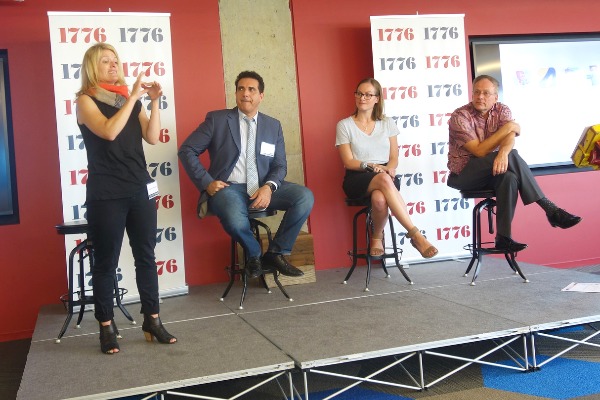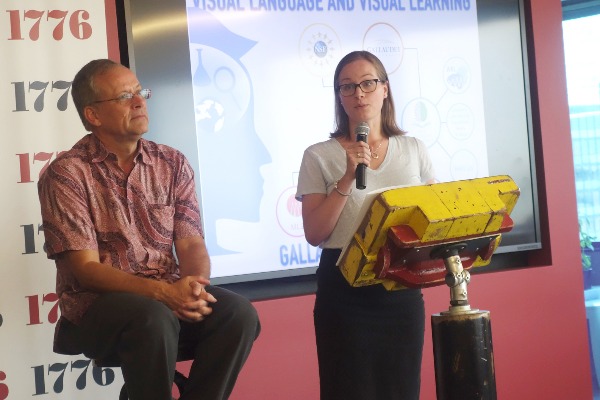ML2 co-directors speak at global summit


The co-directors of the Motion Light Lab, a resource hub of the National Science Foundation and Gallaudet University Science of Learning Center, Visual Language and Visual Learning (VL2), recently participated in a panel at the first annual World Summit on the Creative Economy and Creative Industries.
Malzkuhn speaks at summitMelissa Malzkuhn, creative director of VL2’s Motion Light Lab (ML2), and Dr. Lorna Quandt, ML2 science director and assistant professor in Gallaudet’s Ph.D. in Educational Neuroscience program, participated in the "Redesigning Learning for the Creative Economy" panel on Thursday, July 28, 2016.
The summit, hosted by the Creative World group, was part of a two-week launch of a global initiative by the group and its partners. Malzkuhn and Quandt joined speakers from 14 nations and of diverse backgrounds and disciplines who discussed insights and ideas about creative economy and how creative businesses contribute to growing economies in various regions and countries.
Quandt speaks at summitIn particular, Malzkuhn and Quandt described how ML2 combines creativity and technology with groundbreaking scientific discoveries about the brain and learning by Dr. Laura-Ann Petitto’s Brain and Language Laboratory for Neuroimaging (BL2) to advance innovation and develop translational products that benefit children, particularly deaf children at risk for language deprivation.
"We shared how our BL2 and ML2 avatar improvements are pushing science and technology to advance as a whole. We described our work on increasing the fluidity of face, body, and limb movements in order to achieve the high demands required for avatars to fluently express the complex natural signed languages of deaf people around the world. This work is fundamentally contributing new insights into how to improve avatar science, and it also advances the technology and industry at large," Malzkuhn said. "We also explained how this work is having translational impact and provided examples of powerful translation from our storybook apps that engage children by bridging storytelling and creative literature into digital platforms that are having a global impact."
The summit enabled attendees to look through a new lens at how institutions and businesses deliver products with tangible benefits and how intersectionality among different disciplines can boost economies and create a more globalized space, Malzkuhn and Quandt said.
"VL2, and Gallaudet, are a frontrunner of creating a diverse, globalized space that welcomes diverse people," Malzkuhn said. "With Gallaudet’s student body from different countries, its bilingual mission, and unique Deaf culture, combined with VL2’s research-based and designed products, we can truly make a difference."
Quandt agreed and added that attendees showed significant interest in the synergy at VL2 between science and research with creativity and technological innovation.
"I found it surprising how many people saw connections to the creative parts of our work, particularly in ML2, and were interested in bringing us and our work into whatever they were doing," Quandt said. "People see the value of art and creative enterprises coming out of a scientifically based center."
"The advances we are making in VL2 — in BL2 and ML2 — have huge implications for a global creative economy," said Petitto, co-principal investigator and science director of VL2 and founder and scientific director of BL2. "With the support of NSF through its INSPIRE award, our work on merging multiple technologies — neuroimaging, eye-tracking, robotics, motion capture, and avatars — puts VL2 and Gallaudet on the forefront of scientific research and technological advance, which, in turn, has powerful translational impact and innovation such as new ways to teach young babies language or toddlers how to read. I am proud of my team and thrilled about this opportunity to showcase our work as an example of how science and innovation enables the United States to make an impact on society and gain a technological edge in the world."